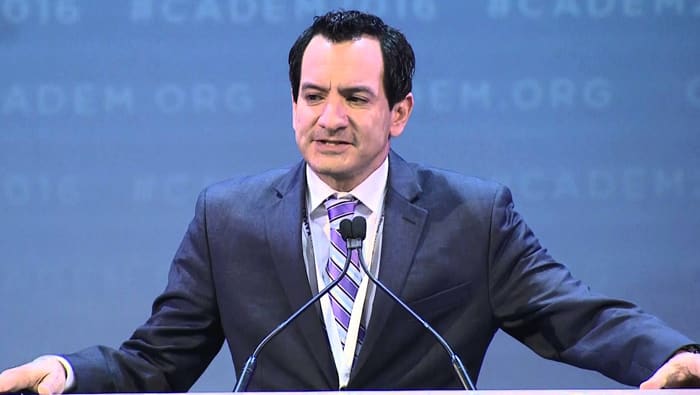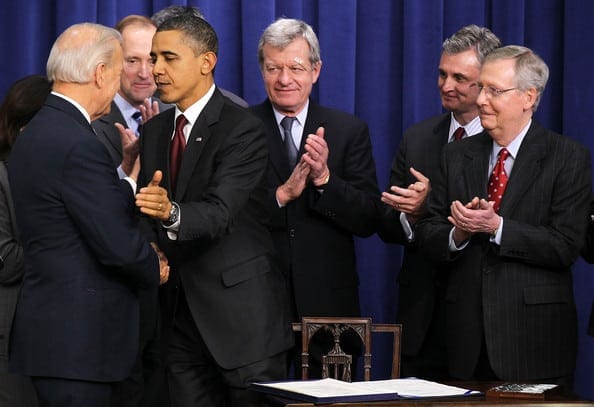Medicine for the People: Single-Payer and Beyond
by MARK HARRIS
The movement for a single-payer health care system in the United States represents a vision of basic access to health care for everyone. As popularly expressed, the demand for “Improved Medicare for All” rightly embraces the idea that health care should be every human being’s right, not a privilege dependent on a person’s income, wealth, or age.
Who could object to such a simple concept of justice, right? Actually, for decades the answer in the United States is just about everyone with money, influence, and power. The historic opponents of health care human rights include the insurance industry, Wall Street, the national leadership of both Republican and Democratic parties, and even the American Medical Association (AMA). All have long stood as obstacles to establishing health care as a human right. In the 1960s, right-wing ideologue Ronald Reagan and others of his persuasion even opposed the establishment of Medicare, likening it to the second coming of Bolshevism.
This is the way it is in ultra-capitalist America, land of for-profit everything. But this is also a nation with a rich history of social protest that sometimes leads to victories for the people. Indeed, from the eight-hour day to “the weekend,” women’s right to vote, minority civil rights, and the struggle for democracy itself, everything right and just in American life is essentially a product of social and political activism for progressive change.
Unfortunately, while most modern nations long ago established health care systems that make access to care widely available at no or low-cost, the United States remains a provincial backwater of health care reaction, cruelly and stupidly denying the right of society as a whole to the resources of medicine. The establishment of Medicare, Medicaid, and the Veterans Health Administration offer only a partial rebuttal to this otherwise underwhelming social history.
Goodbye, Insurance Profiteers
[dropcap]T[/dropcap]oday, there’s new popular momentum building for a national single-payer health care system, driven by both the dogged right-wing assaults on the Obama-era Affordable Care Act (ACA) and the intrinsic structural failures of the current for-profit system. Hopefully, this grassroots single-payer activism will continue to mobilize growing public support for a new health system, one that will permanently oust profiteering insurance industry parasites and similar exploiters from the corporate swamplands.
In today’s volatile political environment, Sen. Bernie Sanders (I-VT) has introduced new legislation to establish a single-payer system. Notably, Senate Resolution 1804 earned quick endorsement after it was introduced from about one-third of Senate Democrats. In the House of Representatives, Rep. John Conyers’ (D-MI) House Resolution 676 also has support of about half of Democratic representatives. The House legislation (reportedly the better bill) establishes “free health care that includes all medically necessary care, such as primary care and prevention, dietary and nutritional therapies, prescription drugs, emergency care, long-term care, mental health services, dental services, and vision care.”
But before we get our legislative hopes up too high, a splash of cold water is in order. For years, Democratic Party leaders have done next to nothing on behalf of the single-payer vision. Actually, from the Clinton to the Obama administrations, they’ve actively sabotaged it, despite its long-standing popularity with the public.
In fact, when “health care reform” was on the agenda in 2009, President Obama very quickly knocked single-payer off the table, despite praising it as ideally the best system in years past. Once in power there would be no discussion of this option. The newly elected president’s intention was less genuine reform than to tinker just enough with the “free market” system to essentially strengthen for another generation the existing insurer/investor dominated health care system.
Today, we see the results. Increasingly, the ACA’s marketplace insurance subsidies and protections for pre-existing conditions offer faint protection from the unchecked reality of rising insurance premiums and super-high deductibles. Under the ACA, there are still 28.2 million uninsured adults under the age of 65, some 10.4 percent of the population, according to the Centers for Disease Control (CDC). It’s true this is the lowest uninsured rate since 1972. The previous four decades it hovered in the range of 16 percent. But such figures still pose the question: Is a 10 percent uninsured rate, coupled with inadequate, over-priced insurance, really the best this nation can offer? Under mostly private, for-profit health care, with the two major political parties under permanent thrall to corporate interests, the answer is essentially, Yes.
Of course, this is hardly a news flash. The ACA was always a poor solution to issues of access and affordability. To the extent some leading Democrats now attach themselves to the single-payer bandwagon, it’s a sign of the gathering public storm for a better, more just public system. Hopefully, the winds of this storm will be strengthened less by faith in Congress than by ongoing public activism, organizing, and protest.
Cynically, Democratic Party leaders have long proven themselves more than willing to rally around high ideals when those ideals have little immediate chance of succeeding. They’re hack geniuses at taking a great idea and watering it down with endless business-friendly compromises, (e.g. Fight for $15), then asking us to wait years and years until “the vision” can finally be fully implemented. With its proposed four-year implementation, Sanders’ Senate resolution already contains this built-in mechanism to potentially deflate any future legislative victory.

Rendon: No further evidence needed. Mark this toxic Democrat as an enemy of the people. and don't forget it. Gov Jerry Brown was in on this, too. This is the kind of traitor to the public interest that the masses should eventually retire permanently.
In California recently, Democratic State Assembly Speaker Anthony Rendon, offered another lesson in the artful leadership style of blending pleasant liberal rhetoric with practical obstructionism on the road to accomplishing nothing. After the California senate voted in favor of establishing a statewide single-payer system, Rendon, citing cost and other concerns, took steps to block the legislation supported by the California Nurses Association from coming before the entire State Assembly. The bill would have established a state mandate to create a single-payer system, eliminating premiums, copays, and deductibles. Rest assured the Speaker of the Assembly supports more hearings on the issue!
We should expect more of the same tepid “leadership” from Democrats as the popular movement for single-payer grows. It will be a tough battle. From neoliberal Democrats to far-right Republicans and every bought-off political type in-between, the U.S. political establishment with rare exceptions cannot quite imagine the multi-billion-dollar insurance industry releasing its financial death grip on the business of medicine. If the people want a fair, equitable, and affordable health care system—if they want health care justice—they will have to organize a strong, fighting grassroots movement for single-payer. Demonstrations, picket lines, teach-ins, strikes and every form of mass public pressure must make it politically untenable for politicians not to support single-payer, insurance lobbyists be damned.
Access, Yes: But to What Exactly?
The future of the campaign for single-payer has a lot going for it, starting with the fact that most modern nations already have some form of it. If American leaders were smart, they would learn from the world’s experiences with health care systems. But they are less smart than savants of opportunism, power, and money. For those who do want to learn, however, there’s invariably much detail to consider in any broad comparisons of world health systems, especially as single-payer or national health care systems in Europe, Australia, and New Zealand have important organizational differences.
But some lessons are more obvious than others. Today, according to a recent Commonwealth Fund report, U.S. health care performance ranks last among 11 “high-income” nations in measures for access, equity, and outcomes. In administrative efficiency, the United States earns a ranking of next to last, based on reports of providers and patients.
“The United States begins with a challenge: its population is sicker and has higher mortality than those of other high-income countries,” write Eric C. Schneider, MD, and David Squires, MA, two of the report’s co-authors in the New England Journal of Medicine (NEJM). Generally, death rates for conditions considered amenable to medical intervention is “far higher than other high-income countries.”
To be fair, not all is bad. The U.S. system performs well for care related to some disease-specific outcomes, such as heart attack, ischemic stroke, colon cancer, and breast cancer. But overall, say Schneider and Squires, “timely access to preventive, acute, and chronic care” is consistently undermined in this country by costs, administrative burdens, and significant social and economic barriers. Nor does the United States rank high in comparative investment in primary care, which is generally the main portal for how most people access health services. Not only is primary care relatively downplayed in the United States, in favor of more specialty care resources, but those who use it routinely face “byzantine layers of administration” that make obtaining and paying for care complex and difficult.

Obama in photo-op being applauded by accomplices for smoothly betraying the public interest in terms of national health care. Sycophantic mainstream media has no incentive to educate the public about these vital issues, let alone unmask the role of corporatised politicians.
The bureaucratic barriers to care are bad enough, but existing public health challenges are also set against the pervasive spectacle of a society starkly divided by wealth and poverty and what the NEJM authors describe as a “less robust social safety net” than other “high-income” countries. “Other countries achieve better population health by spending relatively more on social services than on medical care,” state Schneider and Squires. For a nation’s health to prosper, people need full and affordable access to the health system, especially primary care, bolstered by social policy that supports stable housing, education, nutritious food, and public transportation. In the health care system, they conclude, such progressive social policy would translate into reduced need for emergency, hospital, and long-term care services.
In terms of social policy, there’s another public health benefit to single-payer rarely mentioned in these discussions. As socialist writer Paul Street notes in a recent commentary, “With improved Medicare for All in place, lower-paid workers no longer would be compelled to take second and third jobs to pay for health insurance and to save up for possible future medical emergencies. At the same time, single-payer would remove a major structural incentive pushing employers to extract as much work as possible out of each of their full-time, benefit-receiving, salaried workers: the high costs of employee health care, equivalent to 40 percent of total compensation of salaried employees.” One result of such changes might be less physical and mental illness among many over-worked, over-stressed American workers.
From Sweden to Cuba, Better Ways Exist
If you want a further sense of the crude injustice of social policy in the United States, consider what is possible even in other capitalist nations. In Sweden, the largely government-funded health system is decentralized at the level of county councils and municipalities, and financed through taxes (private health services constitute just a small percentage of the system). There, a primary care visit will cost somewhere in the range of $12 to $37, specialist fees a maximum of about $50, and hospital stays a maximum of about $12 per day. For most Swedes, the ceiling on prescription drug costs is under $300 per year.
With more extensive social support services and long traditions in midwifery, Sweden also has a very low infant mortality rate, 2.4 for every 1,000 live births up until age 1, according to the World Health Organization. By contrast, at 5.7 per 1000 live births, the comparable rate in the United States is more than double Sweden’s.
According to the Swedish government website, pregnant women also receive free or subsidized prenatal care courses during pregnancy. After a child is born or adopted, Swedish parents have the right to 480 days of paid parental leave until the child turns eight, most of it at about 80 percent of their regular pay. By law, parents can also reduce their working hours by 25 percent for a period of time without fear of losing their jobs.
In socialist-oriented Cuba, the health story goes even further. There, despite more limited economic resources, the availability of free, universal public health care combines with generally egalitarian social policies to contribute to impressive public health accomplishments. Cuba’s infant mortality rate of 4.3 per 1000 live births up until age 1 is also lower than the United States. Overall, the average lifespan in Cuba is now 79.1 years, a rate comparable to or exceeding the richest nations.
Notably, with 6.7 physicians per 1,000 people, nearly triple the U.S. rate, Cuba also has the world’s second-highest ratio of physicians serving the public. As Edward W. Campion, M.D., and Stephen Morrissey, PhD, observe in a 2013 NEJM report, “There are too many doctors. Everybody has a family physician. Everything is free, totally free—and not after prior approval or some copay.”
As visitors, Campion and Morrissey describe a system they say can appear almost “unreal” to those from the United States. “The whole system seems turned upside down. It is tightly organized, and the first priority is prevention. Although Cuba has limited economic resources, its health care system has solved some problems that ours has not yet managed to address.”
How is this possible in such a small, relatively poor country? There’s a rich history contained in this question, but it’s significant that the Cuban medical system emphasizes primary and preventive care, free of charge, with delivery organized on a community basis. But what is key is what the Cubans don’t have: the capitalist profit motive to distort how they use the island nation’s resources.
Unlike some Asian nations such as China or Japan, one deficiency of most single-payer/national health systems in the West is their limited support for “complementary and integrative medicine” practices as covered benefits. In contrast, Cuban medical schools with their emphasis on primary care and family medicine also incorporate aspects of natural and traditional medicine, such as acupuncture and herbal medicine, into their core medical curriculum. Such integrative medical practices are not only cost-effective, but provide many patients with an additional complement of treatment options.
For the People: Integrative, Holistic Medical Care
The United States would be well served to follow Cuba’s lead in these practices. Consider, for example, the current epidemic-level use of opioid drugs in the United States. There is evidence the flames of this public health crisis are being fanned in part by for-profit insurance companies that prefer covering lower-cost, highly addictive pain medications over more costly, but safer medication alternatives.
Actually, there exist many non-drug alternatives for pain treatment. The American Academy of Family Physicians (AAFP) recently began recommending various “nonpharmacologic” treatments as first-line therapy for patients with chronic or acute or sub-acute low-back pain, conditions often linked to potential opioid use. These include use of heat, massage, acupuncture, spinal manipulation, exercise, and other treatments.
There is evidence for the benefits of these generally safer, non-drug alternatives. To cite just one example, the Annals of Internal Medicine reported in 2015 that patients with chronic neck pain experienced “significant reductions” in pain and associated disability when their usual care was combined with either 12 acupuncture sessions or 20 one-to-one Alexander technique sessions. (The latter is a body-oriented therapy that seeks to adjust body postures to relieve physical stress).
In any proposed new single-payer system, the American public would be well served to have greater access to the benefits of such potentially helpful treatments. Notably, the Joint Commission, the accrediting body for many healthcare organizations, agrees. Starting in 2018, the Joint Commission will require accredited hospital organizations to provide acupuncture and other non-pharmacological options to meet pain management standards.
In the democratic spirit, single-payer health care should make available beneficial treatments people are already widely using. This certainly includes care now often inadequately covered by insurance, such as vision, dental, mental health, and long-term care services. But it also should include consideration of complementary or integrative medical practices (as they’re known in the west) commonly used by the public.
According to the National Center for Complementary and Integrative Health, U.S. citizens annually spend about $30.2 billion on “complementary health approaches” such as herbal products, chiropractic, yoga, and other resources. A significant portion of these expenditures—$14.7 billion—cover out-of-pocket costs for chiropractic, acupuncture, and body work/massage.
The popularity of so-called alternative or complementary health care is likely derived in part from its generally more humanistic, “hands-on” approach to care. Considering how stressful life is in modern society, this is hardly surprising. Rampant class inequality, cutthroat economic pressures, social isolation and insecurity, set against the backdrop of a violent, militaristic culture, have produced widespread social alienation. In various ways, many people want escape from the soul-destroying predations of our capitalist culture, including the corporate medical culture. An industrial medical system that routinely offers patients 15- or 20-minute visits with overly busy physicians, whose practice largely involves test orders, drug prescriptions, and patients sent away with a hefty bill, is one built to breed public dissatisfaction.
Obviously, patients may need the blood pressure monitor and the stethoscope, the MRI or the prescription, but many also want more holistic, compassionate medicine that touches the heart of their lived human experience. In this sense, the vision of health care as a human right should embrace more than just the medical system’s administrative liberation from capitalist profiteers. The dream of a liberated, just society demands not only full, equal, and affordable access to health care for every person, but also compassionate, patient-centered community health care. The liberation of medicine should also mean a more egalitarian medical culture, where a sense of practitioner-patient partnership prevails over the traditional medical fiefdom ruled by the Gods of the White Coats.
Science: For the People, Not Corporations
[dropcap]T[/dropcap]his more humanistic vision of medicine does not imply an “anti-science” perspective, nor does it disparage the value of randomized controlled trials (RCTs) and other modern research tools. But it does offer a counterweight to the “evidence-based” medical focus of recent decades, with its singular claims to medical authority. After all, RCTs as the research gold standard are not applicable to every area of medical practice, both for practical and ethical reasons. Nor is gold the only currency with which to take the measure of medicine. Along with research studies, there is wisdom in clinical encounters and reported patient experiences. There is also the recognition that even evidence-based treatment guidelines must always be individualized to the patient. In the real world, medical knowledge is a stream fed by many sources.
Actually, “the science” in for-profit capitalist health care isn’t necessarily even always that good. In their 2015 book, Ending Medical Reversal, Vinayak K. Prasad, MD, MPH and Adam S. Cifu, MD, respectively of Oregon Health & Science University (OHSU) and the University of Chicago, conclude that as much as 40 percent of what is considered “state-of-the-art” evidence-based medicine eventually turns out to be either unhelpful or even harmful. These researchers also call out the corrupting influence of money on medicine, from clinicians and researchers who take money from Big Pharma to physicians and clinics with vested financial interests in recommending certain tests or procedures.
Unfortunately, for more extreme “science-based medicine” zealots, which is a distinct minority of physicians and researchers in the United States, all traditional or alternative medicine represent a turn to “quackery,” “woo” or whatever other insolent terminology they prefer to use as a cudgel against practices that don’t fit their familiar conceptions. There is a current of western cultural prejudice, a kind of Ugly American medical imperialism, that lurks unstated among such out-of-hand dismissals of all and every so-called alternative practice or older indigenous medical traditions.
Indeed, there is something deeply ignorant (not to mention elitist) in western trained doctors who arbitrarily dismisses the value of Traditional East Asian Medicine (e.g. acupuncture, Qi Qong, herbal medicine, moxibustion, Asian massage, etc.), for example, with its long and profound history as a medical practice. Such narrowly defined “pro-science” dogma has about as much to do with “scientific medicine” as the Marx-Engels-Lenin Institute under Stalin had to do with “scientific socialism.” Medical science should be a path illuminated by floodlights of creative critical thinking, not some pinched, authoritarian caricature of science that leaves little room for credible medicine much beyond prescription drugs, blood labs, diagnostic tests, and surgical procedures.
Fortunately, the growth of integrative medicine departments at many major U.S. medical centers attests to the fact that more western physicians now reject narrow-minded dogma about what constitutes ‘pro-science” health care. In service to the public, revolutionary single-payer health care should reflect this trend toward integration of indigenous global medical practices.
Medicine, Society, and Public Health
Interestingly, Prasad and Cifu in their book remark in passing that national health care systems tend to lend themselves to successful observational cohort studies into the causes of disease. It’s an important point. The more advanced the national infrastructure of health care resources and services, the easier it is to organize and coordinate resources for public health campaigns.
It’s a point also implicitly in contrast to the ideological nonsense of right-wing conservatives, for whom “there is no such thing as society,” as British Prime Minister Margaret Thatcher famously declared in the 1980s. For her there were just individuals and families and the brutal “right” of each to succeed or fail. But if it’s true that epidemics, hurricanes, and earthquakes (or opioid abuse epidemics) strike individuals and families, it is also true that it takes a society to respond to such public health crises.
Contrary to the conservative mind-set, emergency rooms or “GoFundMe” pages are not an alternative to a universal, non-profit public health care system. Single-payer health care is a sensible reform in terms of patient access, affordability, and organizational efficiency. But even more, it is desirable because it expresses the essential idea that human needs, not private profit, should define and inform political and social policy.
Today, we need a broad-based mass movement for single-payer, rooted in street power, grassroots activism, and independent leadership. With strong mass support, it’s in time a winnable political campaign. Our ideal should be a health care system revamped as a free national public service, union-based and democratically run, and working in unison with the neighborhoods and communities it serves. With such a system in place, health care as a human right could acquire a richer, more fulfilled definition in terms of the holistic practice of medicine itself.
“The practice of medicine has long been dominated by science,” writes Suzanne Koven, MD, for the Los Angeles Review of Books. “But in recent decades patients, and many physicians, have been coming to the conclusion that evidence-based treatments by specialists (and sub- and sub-subspecialists) don’t necessarily supply what people need to heal.” A writer in residence at Massachusetts General Hospital in Boston, Koven observes that it’s not unusual now for physicians and nurses to routinely “team up” with mental health professionals, alternative practitioners, social workers, and chaplains to provide more holistic medical care for patients.
It’s a valuable approach, she says, but she also notes that even this may not be enough. “I’m not sure that even holistic medicine fully acknowledges the difficult-to-measure therapeutic effects of empathy, attentiveness, humor, intuitive reasoning, the ability to inspire hope, and other qualities sometimes called ‘soft skills’ (or, more appreciatively, ‘the art of medicine’) and which are as useful in my practice as penicillin, if not more so,” concludes Koven.
With such a philosophy in mind, one that recognizes both the science and the art of medicine, a single-payer health care system could empower itself to best meet the challenges involved to cure illness, ease suffering, and promote a healthy, nurturing environment for all human beings.
MARK HARRIS—Single-payer health care is a sensible reform in terms of patient access, affordability, and organizational efficiency. But even more, it is desirable because it expresses the essential idea that human needs, not private profit, should define and inform political and social policy.
[premium_newsticker id=”154171″]
This work is licensed under a Creative Commons Attribution-NonCommercial 4.0 International License.
Parting shot—a word from the editors
The Best Definition of Donald Trump We Have Found
 In his zeal to prove to his antagonists in the War Party that he is as bloodthirsty as their champion, Hillary Clinton, and more manly than Barack Obama, Trump seems to have gone “play-crazy” -- acting like an unpredictable maniac in order to terrorize the Russians into forcing some kind of dramatic concessions from their Syrian allies, or risk Armageddon.However, the “play-crazy” gambit can only work when the leader is, in real life, a disciplined and intelligent actor, who knows precisely what actual boundaries must not be crossed. That ain’t Donald Trump -- a pitifully shallow and ill-disciplined man, emotionally handicapped by obscene privilege and cognitively crippled by white American chauvinism. By pushing Trump into a corner and demanding that he display his most bellicose self, or be ceaselessly mocked as a “puppet” and minion of Russia, a lesser power, the War Party and its media and clandestine services have created a perfect storm of mayhem that may consume us all.— Glen Ford, Editor in Chief, Black Agenda Report
In his zeal to prove to his antagonists in the War Party that he is as bloodthirsty as their champion, Hillary Clinton, and more manly than Barack Obama, Trump seems to have gone “play-crazy” -- acting like an unpredictable maniac in order to terrorize the Russians into forcing some kind of dramatic concessions from their Syrian allies, or risk Armageddon.However, the “play-crazy” gambit can only work when the leader is, in real life, a disciplined and intelligent actor, who knows precisely what actual boundaries must not be crossed. That ain’t Donald Trump -- a pitifully shallow and ill-disciplined man, emotionally handicapped by obscene privilege and cognitively crippled by white American chauvinism. By pushing Trump into a corner and demanding that he display his most bellicose self, or be ceaselessly mocked as a “puppet” and minion of Russia, a lesser power, the War Party and its media and clandestine services have created a perfect storm of mayhem that may consume us all.— Glen Ford, Editor in Chief, Black Agenda Report
window.newShareCountsAuto="smart";














